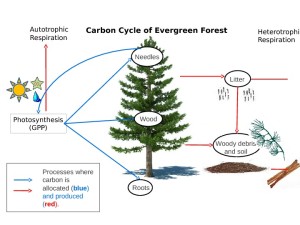 Congratulations to Anna Chuter for successfully passing her PhD viva on 22 January. Anna’s thesis was on “A qualitative analysis of the data assimilation linked ecosystem carbon model DALEC“. Anna was supervised by Philip Aston and Anne Skeldon with help from Ian Roulstone. The examiners were Professors Shaun Quegan (Sheffield) and Rebecca Hoyle. An abstract of her thesis follows. Due to changes in our climate and environment, partly caused by human behaviour, it is becoming increasingly important to understand the processes involved in Earth systems, such as the carbon cycle. There are many models that attempt to describe the dynamical behaviour of carbon stocks and stores, but, despite their complexity in attempting to describe all crucial processes, significant uncertainties remain. Our aim is to look at the qualitative behaviour of one of the simplest carbon cycle models, the Data Assimilation Linked Ecosystem Carbon (DALEC) model, and consider in detail the processes involved. DALEC is a simple vegetation model of processes involved in the carbon cycle of forests. Our analysis shows that the dynamics of both evergreen and deciduous forests in DALEC are dependent on a few key parameters and it is possible to find a tipping point at which stable sustainable behaviour of a forest gives way to widespread mortality. We also study and simplify the Gross Primary Production (GPP), a complex photosynthesis function at the heart of DALEC, and create annual maps of the five carbon pools involved, using the simplified and averaged GPP. These results are then used to examine the effects of moisture shocks on the tipping point, as well as to examine parameter sensitivity from both a numerical and analytical point of view. The net ecosystem exchange (NEE) is an important measure of whether a forest is a CO$_2$ sink or source and also serves as a means to find parameters in the model. During the process of examining parameter sensitivity we simplify the Net Ecosystem Exchange (NEE) equation in various ways, depending on which time period is considered. We find that we can identify the sensitivity of NEE to the parameters and furthermore, we find that the NEE becomes more sensitive to some parameters over time and less to others. Furthermore we find that during a certain important time period NEE can be expressed in terms of the annual mean GPP. These results give important insights into what affects the NEE.
Congratulations to Anna Chuter for successfully passing her PhD viva on 22 January. Anna’s thesis was on “A qualitative analysis of the data assimilation linked ecosystem carbon model DALEC“. Anna was supervised by Philip Aston and Anne Skeldon with help from Ian Roulstone. The examiners were Professors Shaun Quegan (Sheffield) and Rebecca Hoyle. An abstract of her thesis follows. Due to changes in our climate and environment, partly caused by human behaviour, it is becoming increasingly important to understand the processes involved in Earth systems, such as the carbon cycle. There are many models that attempt to describe the dynamical behaviour of carbon stocks and stores, but, despite their complexity in attempting to describe all crucial processes, significant uncertainties remain. Our aim is to look at the qualitative behaviour of one of the simplest carbon cycle models, the Data Assimilation Linked Ecosystem Carbon (DALEC) model, and consider in detail the processes involved. DALEC is a simple vegetation model of processes involved in the carbon cycle of forests. Our analysis shows that the dynamics of both evergreen and deciduous forests in DALEC are dependent on a few key parameters and it is possible to find a tipping point at which stable sustainable behaviour of a forest gives way to widespread mortality. We also study and simplify the Gross Primary Production (GPP), a complex photosynthesis function at the heart of DALEC, and create annual maps of the five carbon pools involved, using the simplified and averaged GPP. These results are then used to examine the effects of moisture shocks on the tipping point, as well as to examine parameter sensitivity from both a numerical and analytical point of view. The net ecosystem exchange (NEE) is an important measure of whether a forest is a CO$_2$ sink or source and also serves as a means to find parameters in the model. During the process of examining parameter sensitivity we simplify the Net Ecosystem Exchange (NEE) equation in various ways, depending on which time period is considered. We find that we can identify the sensitivity of NEE to the parameters and furthermore, we find that the NEE becomes more sensitive to some parameters over time and less to others. Furthermore we find that during a certain important time period NEE can be expressed in terms of the annual mean GPP. These results give important insights into what affects the NEE.
